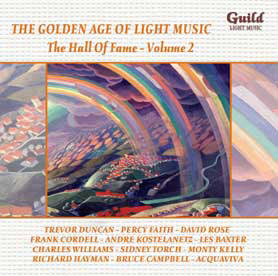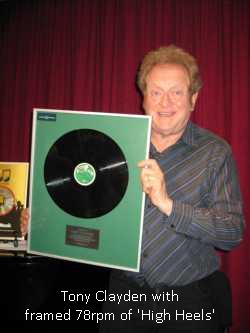HIGH HEELS
(Trevor Duncan)
Analysed
by Robert Walton
When David Rose
wrote Holiday for Strings
he probably didn't realise he had
hit upon a formula so original it
was destined to be emulated all
over the world with varying
degrees of success. It was the
first all-in-one modern mood
music piece containing two basic
human emotions - humour and
passion, sitting quite
comfortably side by side.
Whatever your taste in music it's
a fair bet something in Holiday
for Strings appealed. The
fact that it sold a million seems
to suggest Rose got it right!
That was the green light for many
other composers to try their luck
with the new style. Although its
phenomenal success was never
equalled, the format proved to be
a godsend to the mood music
industry. So the mould was set in
stone. From this prototype came a
flood of similar pieces like All
Strings and Fancy Free, Melody on
the Move, and A Canadian
in Mayfair.
Another
composition clearly coming from
that source was High Heels,
but because it was never
exploited for background music
like other high profile tunes, it
remained comparatively unknown.
However once it had been included
in radio programmes in its own
right, it quickly endeared itself
to light music lovers who went
straight out and bought the
Sidney Torch recording. It was no
million seller, but it had
instant appeal and became a light
orchestral classic.
It's almost
certain that the high heel was
another invention of the great
Leonardo da Vinci in the early
1500s. Fast forward about four
hundred and fifty years to
another Leonard (Trebilco), who
as Trevor Duncan wrote the
definitive musical fashion
statement on the subject in 1949,
inspired no doubt by the
accompanying shoe design of
Christian Dior's New Look - a
return to classic femininity with
a nipped waist and wide skirts.
And this was two years before the
stiletto heel!
Right from the
outset, pizzicato strings with a
French horn overlay give us a
taste of jazzy syncopation known
as Scotch Snap before leading us
gently into the main melody. The
first five notes are the same as Humoresque
but after that, unlike the Dvorak
composition, they go straight up
the scale. Then comes the first
of two triplets that give the
composition a real identity.
There’s nothing quite like
them anywhere else in light
orchestral music. Coupled with
this crisp little tune it creates
one of the most satisfying
experiences in the genre always
producing the feel-good factor.
In fact I still can’t help
smiling each time I hear it!
After that warm
mellifluous experience, the
violins now bowed, leap into
action setting the piece alight
with a thrilling Torch inspired
tune, due in no small part to
more of that syncopated rhythm we
heard in the introduction.
There's also a good example of
portamento (sliding between two
notes). Decorating the sustaining
chord at the end of the first
natural break, the horn is
brought back into service with
three well chosen descending
chromatic notes. On the repeat,
the strings go up a gear, indeed
an octave, singing out even more
dramatically. The goose pimples
should be working overtime. For
me this passage was the defining
moment of the entire piece.
At this point you
would normally expect a return to
the main melody, but unlike Holiday
for Strings, it has another
tune tagged on like an
afterthought, as the violins with
brass support, hurry on down to
their lower register. As soon as
it's over, we go straight back
for a repeat of that stunning
string passage before returning
to the opening pizzicato. Any
other composer might well have
decided to finish as he/she
started, but not Trevor Duncan.
With the bows quickly restored to
the strings, he comes up with one
of the most joyous of codas. The
harp sweeps up to a living,
breathing mass of strings in
harmony, and then unison violins
building up to a tremendous
climax, head off to the heights
for a glorious closing melody,
before diving down to end on a
quiet note.
Unlike the more
traditional light music fare from
an earlier age, High Heels
hasn’t dated. This mid 20th
century masterpiece has retained
its freshness right up until the
present day. As long as
there’s a continuous
appetite for this kind of music,
and there’s no reason why
there shouldn’t be, Trevor
Duncan's attractive melody and
consummate orchestration will be
heard many centuries from now.

High Heels, in its original
Boosey and Hawkes library
version, may be found on GUILD
GLCD 5124 – 'The Hall Of
Fame, Volume 2'

Tony
Clayden was presented with a
framed copy of the original
12" Boosey and Hawkes '78'
record of 'High Heels',
bearing the autograph signature
of Trevor Duncan, at the
inaugural meeting of the London
Light Music Meetings Group in May
2014.
|